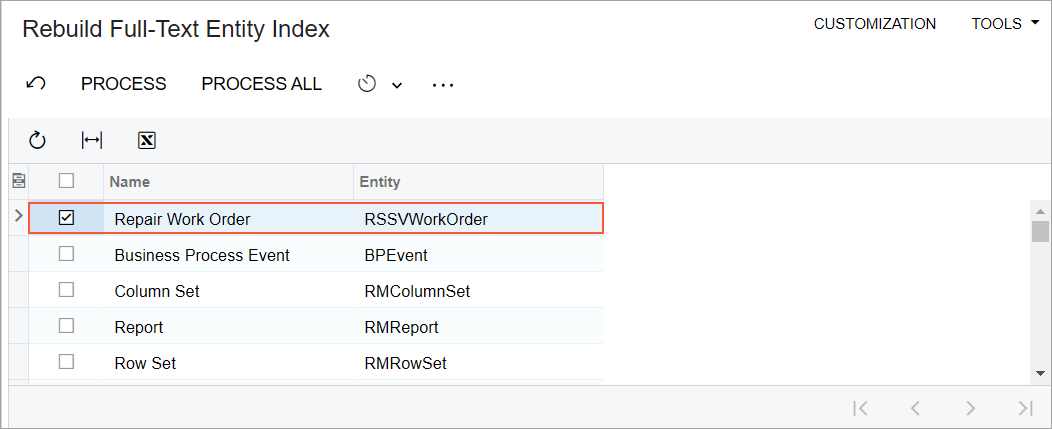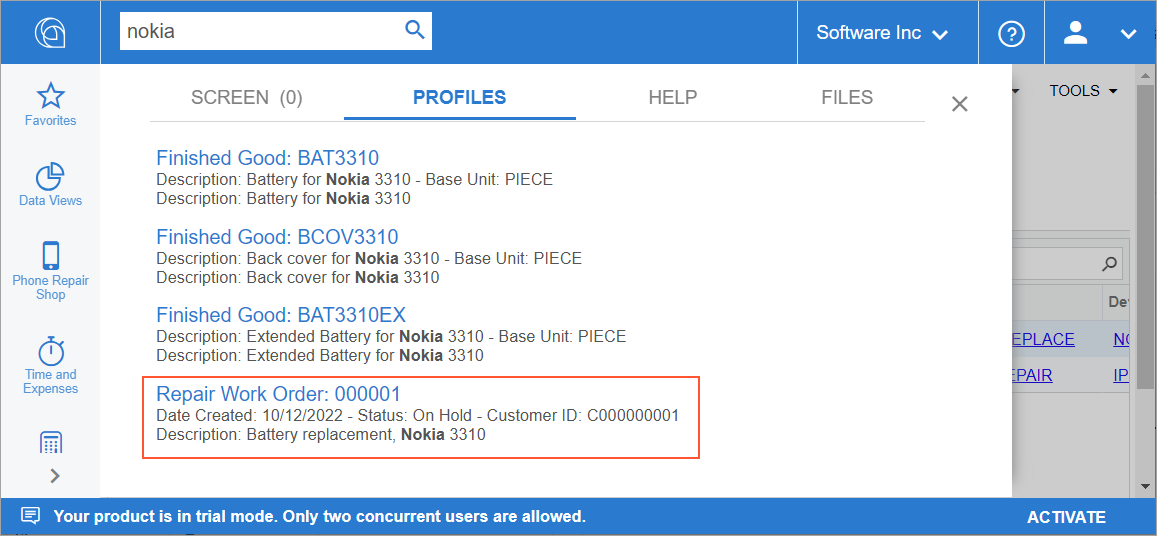Search Customization: To Display a DAC in Universal Search Results
This activity will walk you through the process of including the records of a data access class (DAC) in a universal search in MYOB Acumatica.
Story
Suppose that you have added the RSSVWorkOrder DAC, which contains
information about repair work orders, to the PhoneRepairShop customization project. You need to make this DAC available in a universal search
so that a user can search through the work order number and description.
Process Overview
To implement the universal search for the DAC, you will specify the PXPrimaryGraph attribute for the DAC and declare the PXSearchable attribute for the NoteID field of the DAC. You will then rebuild the search index and test the search.
System Preparation
Before you begin performing the steps of this activity, do the following:
- Prepare an MYOB Acumatica instance by performing the Test Instance for Customization: To Deploy an Instance with Custom Maintenance and Data Entry Forms prerequisite activity.
- Make sure that you have installed full-text search for the Microsoft SQL Server. For details, see Preparation for the MYOB Acumatica Installation: System Environment.
Step 1: Supporting Universal Search in the DAC
To support universal search in the RSSVWorkOrder DAC, do the
following:
- In the
PhoneRepairShop_CodeVisual Studio project, make sure that theRSSVWorkOrderDAC has the PXCacheName attribute, which defines the name that is displayed for the DAC on the Rebuild Full-Text Entity Index (SM209500) form. See the following code.[PXCacheName(Messages.RSSVWorkOrder)] public class RSSVWorkOrder : PXBqlTable, IBqlTable - For the
RSSVWorkOrderDAC, add the PXPrimaryGraph attribute, as the following code shows. The attribute specifies the graph that corresponds to the default editing form for records of the DAC. The records of theRSSVWorkOrderDAC can be edited on the Repair Work Orders (RS301000) form, whose graph isRSSVWorkOrderEntry.[PXPrimaryGraph(typeof(RSSVWorkOrderEntry))] [PXCacheName(Messages.RSSVWorkOrder)] public class RSSVWorkOrder : PXBqlTable, IBqlTable - In the RSSVWorkOrder DAC, make sure that the
NoteID field is decorated with the
PXNote attribute, as the following code
shows.
[PXNote()] public virtual Guid? NoteID { get; set; } public abstract class noteID : PX.Data.BQL.BqlGuid.Field<noteID> { } - Add the PXSearchable
attribute to the NoteID field of the
RSSVWorkOrderDAC, as the following code shows.#region NoteID [PXSearchable( // The category of the search PX.Objects.SM.SearchCategory.All, // The format string for the title of the search result "Repair Work Order: {0}", // The value of the format argument for the title new Type[] { typeof(RSSVWorkOrder.orderNbr) }, // The list of fields where the search should be performed new Type[] { typeof(RSSVWorkOrder.orderNbr), typeof(RSSVWorkOrder.description) }, // The field that contains numbers with prefixes // that should be indexed NumberFields = new Type[] { typeof(RSSVWorkOrder.orderNbr) }, // The format string for the first line of the result Line1Format = "{0:d}{1}{2}", // The values of the format arguments // for the first line of the result Line1Fields = new Type[] { typeof(RSSVWorkOrder.dateCreated), typeof(RSSVWorkOrder.status), typeof(RSSVWorkOrder.customerID)}, // The format string for the second line of the result Line2Format = "{0}", // The values of the format arguments // for the second line of the result Line2Fields = new Type[] { typeof(RSSVWorkOrder.description) } )] [PXNote()] public virtual Guid? NoteID { get; set; } public abstract class noteID : PX.Data.BQL.BqlGuid.Field<noteID> { } #endregionTip:Currently, the category of the search is not used anywhere in the UI. - Rebuild the Visual Studio project.
Step 2: Rebuilding the Search Index
Rebuild the search index as follows:
- On the Rebuild Full-Text Entity Index (SM209500) form, find the
RSSVWorkOrderDAC. - Select the unlabeled check box for the DAC, as shown in the following
screenshot.
Figure 1. The RSSVWorkOrder DAC on the form 
- Click Process on the form toolbar.
Step 3: Testing the Search
To test the search for a record of the RSSVWorkOrder DAC, do the
following:
- In the Search box in the top pane of the MYOB Acumatica screen, type nokia.
- On the Search form, which opens, click the Transactions and
Profiles tab.Review the results of the search, which include the record of the
RSSVWorkOrderDAC, as shown in the following screenshot.Figure 2. Search results 
- Click the record of the
RSSVWorkOrderDAC.The record opens on the Repair Work Orders (RS301000) form.
